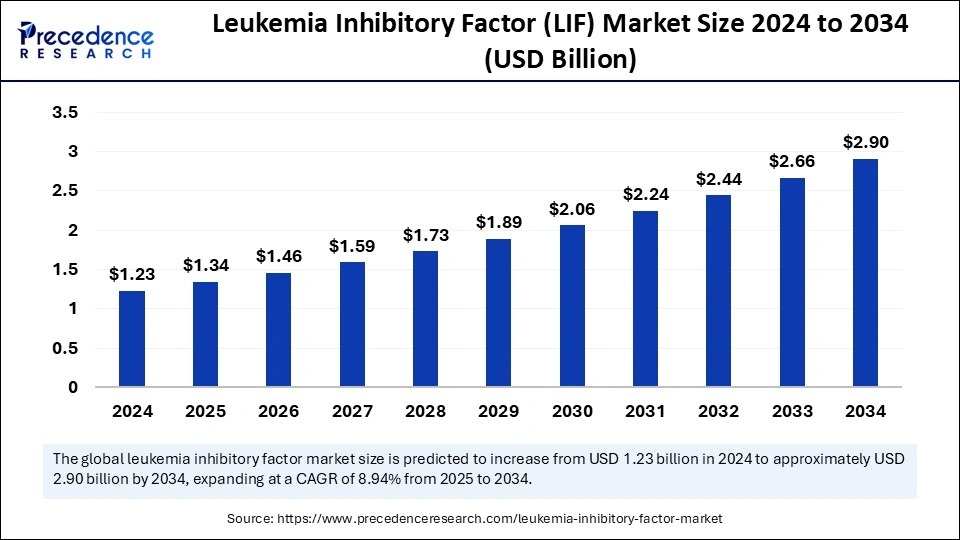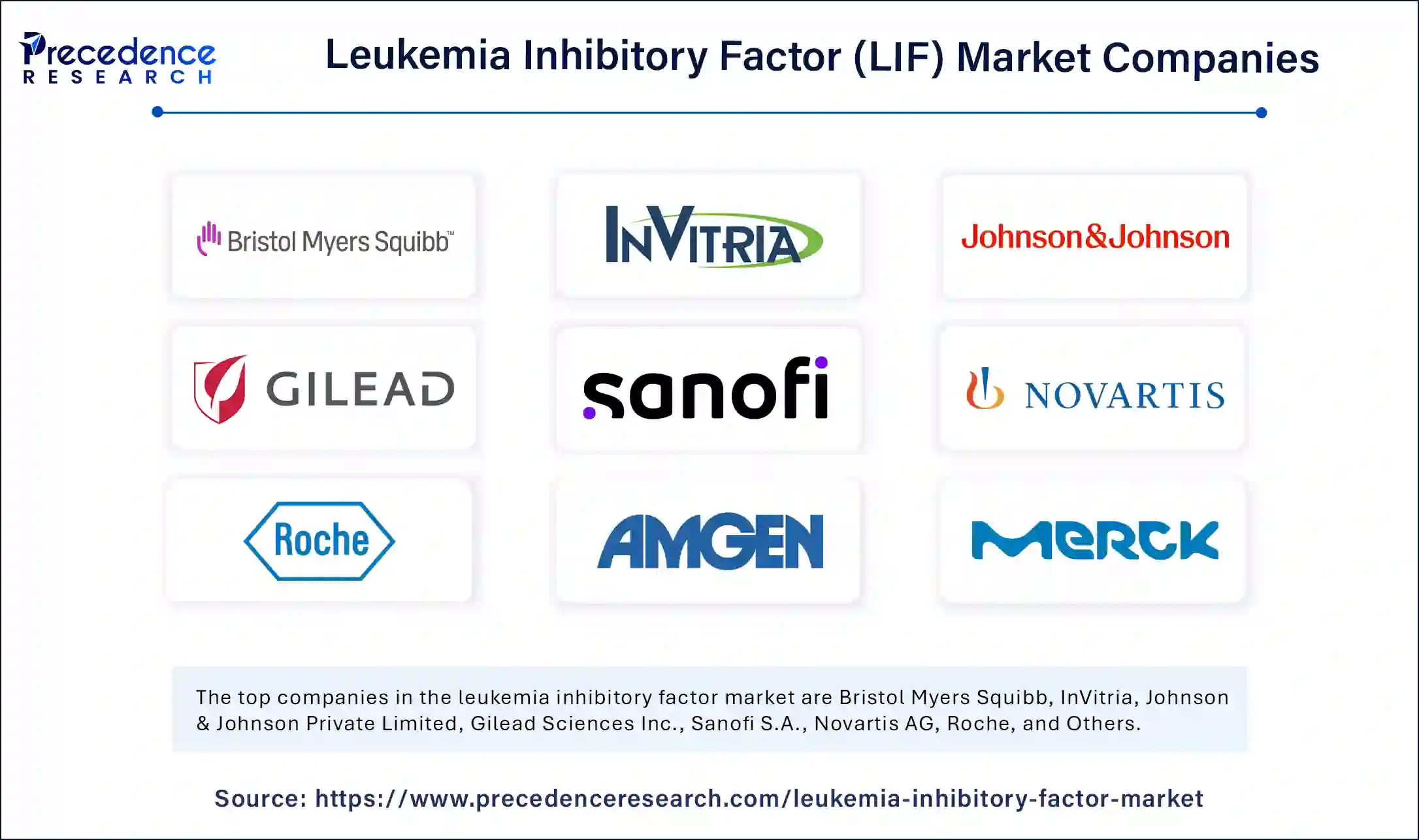The global leukemia inhibitory factor (LIF) market size is estimated to worth around USD 2.90 billion by 2034 increasing from USD 1.23 billion in 2024, with a CAGR of 8.94%.

Get a Free Sample Copy of the Report@ https://www.precedenceresearch.com/sample/5822
Leukemia Inhibitory Factor (LIF) Market Key Points
-
North America maintained its dominant position in 2024, with 41% of the global market.
-
Asia Pacific presents significant growth potential over the forecast period.
-
Europe continues to grow, driven by technological and research advancements.
-
Recombinant LIF products led the market in 2024 across product types.
-
LIF antibodies are expected to show strong performance in the years ahead.
-
Cancer treatment applications held the largest market share in 2024.
-
The stem cell research segment is on track to record the fastest growth rate.
-
Hospitals were the top end user segment in 2024.
-
Rapid expansion is forecasted for research institutes through 2034.
How AI is Transforming LIF Research and Precision Medicine
-
Drug Discovery and Development
AI technologies, including machine learning algorithms, are being increasingly used to identify potential drugs or treatments that can interact with LIF. AI can analyze vast datasets, including genomic data, protein structures, and clinical outcomes, to predict how LIF-related molecules might behave in the body. By simulating interactions between LIF and other compounds, AI helps researchers identify promising drug candidates more efficiently and at a fraction of the time compared to traditional methods. -
Precision Medicine and Personalized Therapies
AI is helping tailor treatments involving LIF to individual patients by analyzing genetic and molecular data. This allows for the development of precision therapies that leverage the effects of LIF to treat specific conditions, particularly in cancer and stem cell therapies. Machine learning models can analyze how LIF interacts with different cellular pathways and identify the most effective treatment regimen for individual patients based on their unique biomarkers. -
Clinical Decision Support
AI-driven clinical decision support systems (CDSS) are increasingly being integrated into healthcare practices to assist clinicians in making better-informed decisions regarding the use of LIF-related therapies. These systems analyze patient data, including history, biomarkers, and treatment outcomes, to offer recommendations on LIF-based treatments. By predicting the potential success of various treatment plans, AI can improve clinical outcomes and reduce the likelihood of adverse effects. -
Predictive Analytics in Cancer Treatment
LIF plays a crucial role in several cancer pathways, including promoting tumor growth and influencing cancer stem cells. AI is used to analyze large-scale clinical data to predict how cancer cells respond to LIF-targeted therapies. Predictive models based on machine learning algorithms can forecast the progression of cancers like leukemia and solid tumors, providing insights into how best to use LIF inhibitors in these treatments. -
Optimizing Research in Stem Cell Therapies
AI is playing an essential role in stem cell research by analyzing how LIF interacts with stem cells. LIF is known to influence stem cell maintenance and differentiation, and AI algorithms can help identify new pathways or mechanisms that might be leveraged for better stem cell-based therapies. By using AI to map the interactions between LIF and stem cells, researchers can accelerate the development of regenerative medicine and stem cell therapies, potentially improving outcomes for conditions like leukemia and other hematologic diseases. -
Monitoring and Real-Time Data Analysis
AI can be used to monitor patients undergoing LIF-related treatments by analyzing real-time health data, such as vital signs, lab results, and imaging. AI systems can detect early signs of adverse reactions or complications, allowing healthcare providers to adjust treatments quickly. This capability is particularly important in managing complex and high-risk treatments like those targeting LIF for cancer therapy.
What is Leukemia Inhibitory Factor (LIF)?
Leukemia Inhibitory Factor (LIF) is a multifunctional cytokine belonging to the interleukin-6 (IL-6) family. It was initially discovered for its ability to induce the differentiation of myeloid leukemia cells, hence the name. However, its biological role extends far beyond leukemia, as it is involved in a wide array of physiological and pathological processes, including cell proliferation, differentiation, survival, immune response, inflammation, reproduction, and neural development.
Key Biological Functions of LIF
-
Stem Cell Maintenance
LIF is crucial in maintaining the pluripotency of embryonic stem cells, especially in mouse models. It prevents stem cells from differentiating, making it an essential tool in stem cell culture and regenerative medicine research. -
Neural Development and Repair
LIF plays an important role in the development and survival of neurons. It is also upregulated in response to injury, aiding in neuroprotection and regeneration. -
Immune Modulation
LIF is involved in modulating immune responses, including suppressing certain pro-inflammatory pathways. It helps regulate the balance between pro- and anti-inflammatory cytokines, which is important in autoimmune and inflammatory diseases. -
Cancer
While LIF was initially studied for its effect on leukemia, later studies revealed its dual role in cancer. In some cases, LIF acts as a tumor suppressor, while in others, it promotes tumor growth, metastasis, and drug resistance, particularly in breast, pancreatic, and colorectal cancers. -
Reproductive Biology
LIF is essential for embryo implantation in the uterus. It plays a critical role in establishing pregnancy, and its deficiency has been associated with infertility. -
Bone and Muscle Development
LIF influences osteogenesis (bone formation) and myogenesis (muscle development), making it a subject of interest in musculoskeletal research.
Clinical and Research Applications
-
Stem Cell Culture: Widely used to maintain embryonic stem cells in an undifferentiated state.
-
Cancer Therapy: A potential target for therapies, especially in tumors where LIF is overexpressed.
-
Fertility Treatments: Investigated for its role in improving implantation success.
-
Neurodegenerative Disease Research: Studied for its neuroprotective effects in diseases like multiple sclerosis and Alzheimer’s.
-
Autoimmune Disease Modulation: Potential use in regulating immune responses in autoimmune conditions.
Market Overview
The Leukemia Inhibitory Factor (LIF) market has gained significant momentum in recent years due to its pivotal role in stem cell biology, regenerative medicine, and cancer treatment. LIF is a multifunctional cytokine that influences various physiological processes such as cell differentiation, survival, and proliferation. Its applications are expanding in areas such as neurobiology, fertility treatments, and oncology, where it is being studied for its potential therapeutic benefits.
The market is seeing increasing interest from both academic and commercial research institutions, driving the development of new LIF-based treatments and research methodologies.
Market Scope
| Report Coverage | Details |
| Market Size by 2034 | USD 2.90 Billion |
| Market Size in 2025 | USD 1.34 Billion |
| Market Size in 2024 | USD 1.23 Billion |
| Market Growth Rate from 2025 to 2034 | CAGR of 8.94% |
| Dominating Region | North America |
| Fastest Growing Region | Asia Pacific |
| Base Year | 2024 |
| Forecast Period | 2025 to 2034 |
| Segments Covered | Product Type, Application, End-User, and Regions. |
| Regions Covered | North America, Europe, Asia-Pacific, Latin America, and Middle East & Africa |
Market Dynamics
Market Drivers
Several key drivers are fueling the growth of the LIF market. The rising incidence of cancer and chronic diseases, coupled with the increasing demand for personalized medicine, is contributing to the market’s expansion. Furthermore, the growing interest in stem cell-based therapies, particularly in regenerative medicine, is driving research into LIF’s role in maintaining stem cell pluripotency.
The advancement of biotech and pharmaceutical industries, along with increasing funding for research and development, is helping accelerate the discovery of new LIF-based therapeutic options, further enhancing its market potential.
Opportunities
The LIF market offers significant opportunities, particularly in areas like cancer therapy, fertility treatments, and stem cell research. The potential to use LIF for targeted therapies in oncology, especially for cancers where LIF plays a role in tumor suppression or promotion, holds promise.
Additionally, LIF’s involvement in the regulation of immune responses presents an opportunity for its use in treating autoimmune diseases and inflammatory disorders. As understanding of LIF’s mechanisms deepens, its applications in tissue engineering and regenerative medicine are also expected to grow, further expanding its market reach.
Challenges
Despite its potential, the LIF market faces several challenges. One major issue is the dual role of LIF in both promoting and suppressing tumor growth, which complicates its use in cancer therapy. Additionally, the high cost of research and development, along with the complexities of producing high-quality LIF at scale, are hindrances to widespread commercialization.
Regulatory hurdles surrounding the use of biologics, particularly in clinical trials and approvals, also present obstacles. Furthermore, the ethical concerns surrounding stem cell research, in which LIF plays a crucial role, can slow the adoption of LIF-based treatments in certain regions.
Regional Insights
North America currently dominates the global LIF market, driven by a strong biotechnology infrastructure, well-established pharmaceutical companies, and significant research funding. The region’s robust healthcare system and increasing demand for advanced therapeutics further contribute to its leadership position.
Asia Pacific is projected to experience the fastest growth in the coming years, driven by supportive government policies, increasing investments in biotechnology, and expanding healthcare infrastructure. Europe is also showing steady growth, with strong academic and research collaborations, particularly in the areas of stem cell research and fertility treatments, which are likely to continue shaping the market in the region.
Leukemia Inhibitory Factor (LIF) Market Companies

- Bristol Myers Squibb
- InVitria
- Johnson & Johnson Private Limited
- Gilead Sciences Inc.
- Sanofi S.A.
- Novartis AG
- Roche
- Amgen Inc.
- Merck KGaA
Latest Announcements by Leaders
- In November 2024, Dr. Marjorie Green, senior vice president and head of oncology of the global clinical development at Merck Research Laboratories announced that the innovative research presented in the 2024 annual meeting at the American Society of Hematology (ASH) showcases the strong clinical development program of Merck and its commitment to exploring novel research and therapeutic targets, as Merck works to enhance outcomes and address unmet needs of consumers with hematologic neoplasms and malignancies.
- In October 2024, Victor Bulto, president U.S. at Novartis, reported that the company felt proud to help redefine the chronic myelogenous leukemia (CML) treatment once again with Scemblix, as Novartis continues to deliver on its 20+ year commitment to innovation and support in CML.
Recent Developments
- In October 2024, Novartis announced the approval from the U.S. Food and Drug Administration (FDA) for the Scemblix® (asciminib) for adult patients who are newly diagnosed with Philadelphia chromosome-positive chronic myeloid leukemia in chronic phase (Ph+ CML-CP).
- In February 2024, Johnson & Johnson in collaboration with Pharmacyclics LLC announced the approval from the U.S. Food and Drug Administration (FDA) for expanding IMBRUVICA® (ibrutinib) with an oral suspension formulation for adult patients going through the treatment of chronic lymphocytic leukemia (CLL), and other related diseased conditions after failure of one or more lines of systemic therapy.
Segments Covered in the Report
By Product Type
- Recombinant LIF
- LIF Antibodies
- LIF Receptor Agonists/Antagonists
By Application
- Cancer Treatment
- Stem Cell Research
- Neurological Disorders
- Fertility Treatment
- Others
By End-User
- Hospitals
- Research Institutes
- Biotechnology Companies
- Others
By Geography
- North America
- Europe
- Asia-Pacific
- Latin America
- Middle East & Africa
Also Read: Intravenous Infusion Pump Market
Ready for more? Dive into the full experience on our website@ https://www.precedenceresearch.com/